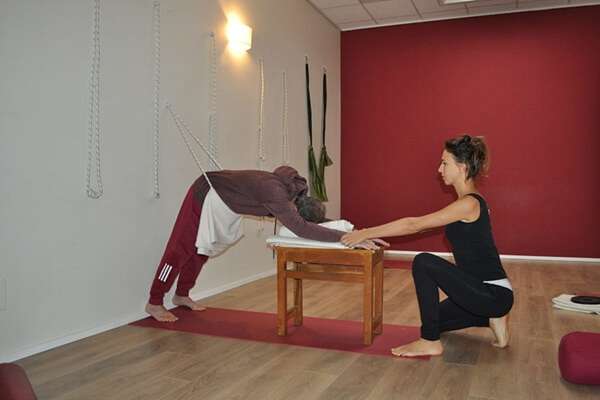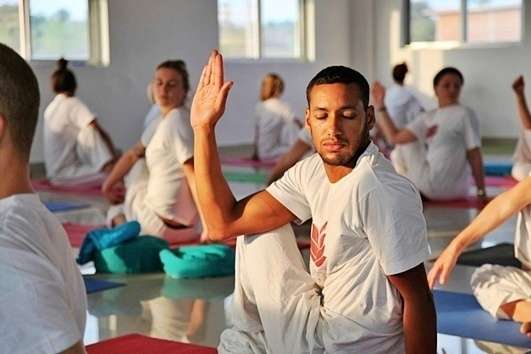Yoga is a form of exercise that has been around for thousands of years and is still just as popular today. It is a holistic practice that not only improves physical fitness but also promotes mental and emotional well-being. Many people think of yoga as just a way to relax and stretch, but it is so much more than that. Incorporating yoga into your fitness routine can bring a host of benefits, both physically and mentally.
In this blog post, we will explore why yoga should be a part of your fitness routine and how it can help you achieve your fitness goals. Whether you are a seasoned athlete or just starting out, yoga can help you become stronger, more flexible, and more balanced in your body and mind. So, read on to find out how yoga can enhance your fitness routine and take your overall well-being to the next level
What is yoga?
Yoga is an ancient practice that originated in India over 5,000 years ago. It is a holistic approach to physical, mental and spiritual well-being. Yoga is a Sanskrit word that means “to unite” or “to yoke” and it is often referred to as a union between the mind, body and spirit.
Yoga is not just about physical postures, or asanas, but also includes pranayama (breathing techniques), meditation, and ethical principles. In yoga, the body is used as a tool to quiet the mind, and the breath is used as a tool to help focus the mind and bring the body into balance.
Yoga is a practice that can be enjoyed by people of all ages and fitness levels. It is a low-impact form of exercise that is gentle on the body, making it an accessible form of exercise for people with injuries or chronic conditions. Yoga can help improve flexibility, strength, balance, and overall fitness, as well as reducing stress and anxiety.
Additionally, Yoga is not just limited to a particular religion or belief system, it is a practice that can be adapted and practiced by anyone, regardless of their background or beliefs. It’s a practice that can be done in the comfort of your own home, or in a class with a qualified teacher. Yoga is a practice that can be tailored to suit the needs of each individual, making it a versatile and adaptable form of exercise.
7 benefits of a regular yoga practice
Yoga is a practice that has been around for thousands of years and has been proven to bring a host of benefits for both the body and mind. Here are 7 benefits of a regular yoga practice:
- Improved flexibility:
Improved flexibility is one of the most well-known benefits of a regular yoga practice. Flexibility refers to the range of motion in a joint or group of joints, and the ability of the muscles surrounding the joints to stretch and move freely. A lack of flexibility can lead to stiffness, pain, and injury.
Yoga postures, also known as asanas, are designed to increase flexibility in the muscles and joints. These postures gently stretch and strengthen the muscles, increasing their range of motion. Regular practice of yoga postures can help to improve flexibility in the entire body, including the spine, hips, shoulders, and legs.
Additionally, yoga postures often involve holding a stretch for an extended period of time, which is known as static stretching. This type of stretching can help to increase flexibility by slowly lengthening the muscles over time.
- Increased strength:
Increased strength is another benefit of a regular yoga practice. Yoga postures, also known as asanas, require the use of your own body weight and engage multiple muscle groups at once. This can help to build strength and muscle tone.
The postures in yoga are designed to target different muscle groups and areas of the body. For example, postures like plank, chaturanga and upward facing dog, which involve holding the body in a steady position, work the core muscles, arms and shoulders. Standing postures such as warrior II, triangle and chair pose, work on legs and hips. Additionally, inversions such as headstands, handstands and shoulder stand require a lot of upper body strength and core engagement.
Yoga also emphasizes the importance of alignment and proper form, which can help to prevent injury and improve overall strength. The practice of yoga encourages the use of correct muscle engagement, which can help to build strength and muscle tone over time.
- Better balance:
Better balance is another benefit of a regular yoga practice. Yoga postures, also known as asanas, require balance and stability, which can help to improve your balance and coordination over time.
Yoga postures often involve standing on one foot, which can help to improve balance by strengthening the muscles in the feet, ankles, and legs. Additionally, postures that require balance, such as tree pose, eagle pose, and warrior III, engage the core muscles and help to improve overall balance.
Some yoga practices also include moving from one posture to another, which can help to improve dynamic balance, which is the ability to maintain balance while moving. This type of balance is important for everyday activities and sports.
Yoga also emphasizes the importance of the breath, which can help to improve balance by calming the mind and helping to focus on the present moment. This can be especially beneficial for people who have difficulty with balance, such as older adults or those recovering from an injury.
- Stress relief:
Stress relief is a well-known benefit of a regular yoga practice. Yoga is a holistic practice that not only improves physical fitness but also promotes mental and emotional well-being.
Yoga involves deep breathing and meditation, which can help to reduce stress and anxiety by promoting relaxation and a sense of calm. The controlled breathing techniques used in yoga, called pranayama, have been shown to reduce the activity of the sympathetic nervous system, which is responsible for the “fight or flight” response. This can help to decrease the physical symptoms of stress such as rapid heartbeat and high blood pressure.
Yoga postures, also known as asanas, can also help to reduce stress by releasing tension in the muscles and promoting relaxation. The practice of yoga also encourages mindfulness and self-awareness, which can help to reduce stress by bringing attention to the present moment and away from worrying thoughts.
- Improved breathing:
Improved breathing is another benefit of a regular yoga practice. Yoga’s breathing practices, called pranayama, can help to improve the function of the lungs and increase lung capacity.
Yoga breathing techniques involve breathing deeply and fully, which can help to increase the amount of oxygen in the body. This can improve the function of the lungs and help to improve overall health.
One of the most popular pranayama techniques is called “Ujjayi” breath or “victorious breath” which is a slow, controlled breath with the glottis partially closed, this technique can help to reduce stress and anxiety, and promote relaxation. Another technique is called “Nadi Shodhana” or “alternate nostril breathing” which involves alternating the breath between the left and right nostril, this technique can help to balance the nervous system and promote a sense of calm.
Deep breathing can also help to stimulate the parasympathetic nervous system, which can help to slow down the heart rate, lower blood pressure, and promote a sense of calm.
- Better sleep:
Better sleep is another benefit of a regular yoga practice. Yoga’s relaxation and breathing techniques can help to improve the quality of sleep by promoting relaxation and reducing stress.
Yoga postures, also known as asanas, can help to relax the body and release tension in the muscles, which can promote a sense of calm and prepare the body for sleep. Yoga’s breathing techniques, such as “Ujjayi” breath, can also help to promote relaxation and reduce stress.
The practice of yoga also encourages mindfulness and self-awareness, which can help to reduce stress and worries that can interfere with sleep. Yoga’s practice of meditation can also help to reduce racing thoughts and promote a sense of calm, which can lead to a better sleep.
- Increased mindfulness:
Increased mindfulness is another benefit of a regular yoga practice. Mindfulness refers to the ability to be present and aware of the present moment without judgment. Yoga encourages a focus on the present moment by bringing awareness to the breath, body and surroundings.
The practice of yoga postures, also known as asanas, requires concentration and focus, which can help to bring awareness to the present moment. Yoga’s breathing techniques, such as “Ujjayi” breath, also require focus and attention, which can help to improve mindfulness.
Yoga’s practice of meditation can also help to increase mindfulness by bringing awareness to the present moment and reducing racing thoughts. This can help to improve mental clarity, reduce stress and anxiety, and promote overall well-being.
Incorporating yoga into your routine can bring these benefits and more, making it an excellent addition to any fitness plan. It’s a practice that can be adapted to suit people of all ages and fitness levels, so whether you’re a beginner or a seasoned yogi, there’s something for everyone.
How to add yoga to your routine
Yoga is a holistic practice that can bring a host of benefits for both the body and mind. If you’re interested in adding yoga to your routine, there are a few things you can do to make it a regular practice:
Set a goal: Before you begin, set a goal for why you want to start practicing yoga. This can be something like “I want to improve my flexibility” or “I want to reduce stress.” Having a clear goal in mind can help to motivate you to stick with the practice.
Find a class or teacher that works for you: Yoga is a practice that can be adapted to suit the needs of each individual. Look for a class or teacher that aligns with your goals and preferences. If you’re new to yoga, it may be helpful to start with a beginner’s class or a class that is specifically designed for your fitness level.
Create a consistent practice: To see the benefits of yoga, it’s important to practice regularly. Try to set aside some time each day or each week for yoga practice. Consistency is key, even if you start with a short practice, it will make a huge difference in the long run.
Incorporate yoga into your daily routine: Yoga can be incorporated into your daily routine in many ways. You can practice yoga postures while watching TV, during a break at work, or even while doing household chores.
Practice at home: You don’t need to attend a class to practice yoga, you can also practice at home. There are many online resources, such as videos and tutorials, that can guide you through a practice.
Be patient: Remember that yoga is a practice and it takes time to see the benefits. Be patient with yourself and don’t get discouraged if you don’t see results right away. The most important thing is to enjoy the practice and have fun.
Incorporating yoga into your routine can bring many benefits, such as improved flexibility, strength, balance, and overall fitness, as well as reducing stress and anxiety. By following these steps, you can start to enjoy the benefits of yoga and make it a regular part of your routine.
FAQ
Q. Is 30 minutes of yoga a day enough exercise?
A. 30 minutes of yoga a day can be a great addition to your exercise routine, but it may not be enough to meet all of your fitness needs on its own.
Q. How much physical activity apart from yoga?
A. Adults should aim for at least 150 minutes of moderate-intensity or 75 minutes of vigorous-intensity aerobic physical activity per week, or an equivalent combination. In addition, adults should also engage in muscle-strengthening activities at least two days per week.
Q. Is walking and yoga enough exercise?
A. Walking and yoga can be beneficial forms of exercise, but they may not provide enough intensity to meet the recommended guidelines for aerobic and muscle-strengthening activity. Adults should aim for at least 150 minutes of moderate-intensity aerobic activity or 75 minutes of vigorous-intensity activity per week, in addition to muscle-strengthening activities 2 days per week.
Q. Can you get fit with yoga?
A. Yoga can be a great way to improve flexibility, balance, and strength, but it may not provide enough intensity to meet the recommended guidelines for aerobic physical activity. To achieve overall fitness, it’s important to include a variety of activities that challenge the cardiovascular system and build muscle strength.
Q. How long should you do yoga a day?
A. It’s recommended to practice yoga for at least 20-30 minutes a day for beginners, and gradually increase the time as your fitness improves. However, it’s important to listen to your body and not push yourself too hard, it’s better to do a shorter session daily than to overdo it and cause injury.


